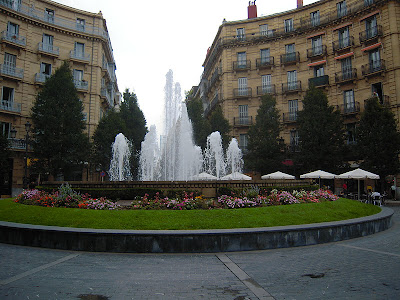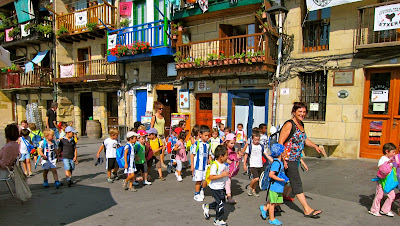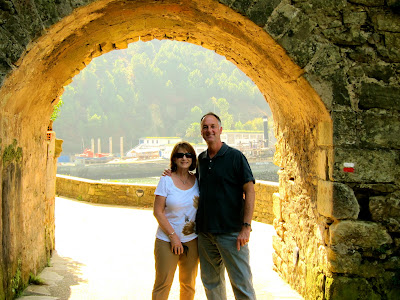Continuing onward from San Sebastian, our well-fed foursome (Tom, Karren, Rex and Charene) drove over the border and through the Landes pine forests into southwest France. We found our way to the Dune du Pyla, Europe's highest sand dune and a slice of the Sahara in France.
I climbed the 400 feet to the top and was rewarded by this beautiful view of a small stretch of the southern Atlantic seaboard of France. Don't I look French in my blue and white striped top?!
You can't go to Bordeaux country without experiencing the wine! The day after we arrived, we headed about 22 miles northeast of the city of Bordeaux (more about the city in my next blog) to the region of Saint Emilion with a local tour guide named Frederic Borliachon of Rendez-Vous au Chateau.
Rex and I have toured many a vineyard over the past few years but this was the FIRST time we have ever been lucky enough to time our visit with the actual harvest. The grapes were plump, sweet and ready for picking!
Our first stop was the Chateau Cadet Bon, where the grapes were harvested by hand and taken into a barnlike structure to begin the process of converting grapes to "Grand Cru Classe de Saint-Emilion" wine. This is what their label looks like.
The grapes are deposited into a machine that destems them, then a handful of workers literally sort through every single grape and discard any that aren't suitable for the next process. The grapes were coming at a fast pace along this conveyor belt. I started getting the giggles because it reminded me so much of the Lucy Show episode where Lucy and Ethel couldn't keep up with the chocolates coming along the assembly line so they kept popping them in their mouths. Anyone remember that?!
The vintner and owner of Chateau Cadet Bon graciously offered us barrel tastings of his wine.
The small village of Saint Emilion itself is spectacular. The town's superb medieval streets, buildings, and monuments are extremely well-preserved and sit up high on a hill. It is a UNESCO World Heritage Site and well-deserving of this distinction.
Carved by Benedictine monks out of solid rock over three centuries in honor of Saint Emilion, the Monolithic Church is the largest and best preserved subterranean church in all of Europe. The damp underground catacombs represent only a small portion of the 70 acres of underground rooms that have yet to be excavated. We took a tour of the catacombs but, unfortunately, we weren't allowed to take pictures.
The cloisters of St. Emilion.
Emilion was a very religious young man and performed many miracles before his death in 767. After completing a pilgrimage to this area of France, he dug out a cave and dedicated his life to God, living there as a hermit. He had done so much good that his name was given to the place where he had lived which became known as St. Emilion.
Graffiti isn't new to our world. Do you see the scratchings on the walls surrounding Saint Emilion? Travelers from many centuries ago left their mark on these walls.
As we walked along the narrow cobblestone streets, Rex discovered some small grapevines for sale. Could this be the beginning of a new venture? If only we were fluent in French......
These watering basins were originally used by the womenfolk to do the laundry. Maytag has come a long way but you have to admit, it was a pretty setting.
The Joneses and the Crouches pose in front of a spectacular background before heading to
the next winery, Chateau Lavergne Dulong.
Sylvie, the owner gave us a tour of her winery and, after a tasting there, she proudly showed us
her chateau, which she has recently refurbished into a beautiful B & B. If I ever come back to this region, I'd love to stay here.
More to come on the rest of our trip in France......















































































